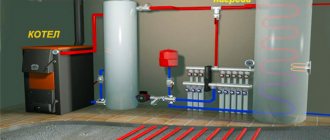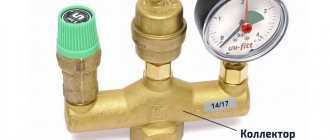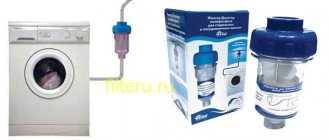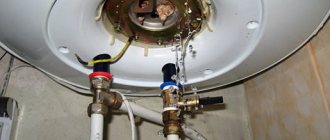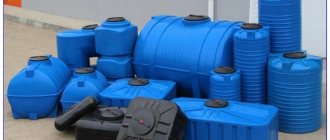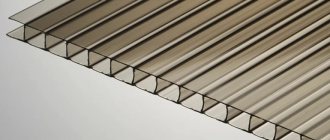Storage water heaters powered by electricity provide the required flow of hot water, but take a long time to reach the temperature - 1.5...2 hours, depending on the volume of the tank. A more attractive option is a special container for hot water, heated by a heating boiler for 10-30 minutes, the difference is noticeable. The purpose of the publication is to explain to users what an indirect heating boiler is, to consider the design of the unit, and to give practical recommendations for choosing and connecting a storage device with your own hands.
Parameters for choosing an indirect heating boiler
Most indirect heating units are installed in houses with an autonomous heating system - if there is none, there is no point in buying a storage unit, since it will not work. In addition, the device costs a lot, so it is advisable to purchase it for at least 2 points of analysis - for 1, an electric instantaneous water heater is better suited.
Before going to the store, based on the consumption mode, as well as the number of mixers and users, the optimal tank volume is determined: for 1 person, a capacity of 80 liters will be enough; for 2 or 3 people – 80...120 l; for 4 or 5 family members – 120...200 l; for 6...8 inhabitants - 200...300 liters.
For a more accurate calculation, water consumption for household needs is taken into account: taking a bath and shower - 150 and 80 l; performing hygiene procedures – 15 l; washing dishes – 30 l; cooking - 15 liters.
1. When choosing, in addition to the volume of the tank, other technical characteristics are taken into account, most of which are interconnected: heat exchanger power (kW), productivity (l/min), heating time (h), maximum hot water temperature (°C) ), operating pressure (bar).
When determining optimal indicators, the power of the boiler and the amount of energy required for the efficient functioning of the heating system must be taken into account.
2. Most boilers are compatible with any boilers, regardless of the type of fuel they use. But there are exceptions - in such cases, a special control unit is additionally installed.
3. Attention must be paid to the area of the heat exchanger, on which, together with the volume of the tank and power, the heating time depends. Naturally, the larger the coil (or tank), the faster the water reaches the desired temperature.
4. The quality of the liquid and the durability of the device are significantly affected by the internal anti-corrosion coating of the steel tank. The most popular is enamel - it is inexpensive, but at the same time not very reliable, since with a large temperature difference it becomes covered with microcracks. The next in rating is porcelain glass, then titanium. The most practical container is made of stainless steel.
5. Additional and no less effective protection of the tank from the inside is a magnesium anode, which, having a low electrochemical potential, “pulls” the oxidation of the steel walls onto itself. As it performs its work, it wears out and requires replacement approximately every 2 years.
6. The coil is made of steel, copper and brass. The last two materials are more preferable - they are more expensive, but easier to clean and do not rust.
7. The efficiency of the unit largely depends on the insulation - it is located in the cavity between the body and the internal tank and performs heat-saving functions. It uses foam rubber, mineral wool, polystyrene foam, and polyurethane foam.
The first material is the cheapest and least practical, the last is expensive, but the water in the container with it cools by no more than 2 °C per day.
8. For units of this type, especially since they are “attached” to the heating boiler, it is necessary to carefully provide a “seating” place.
The drive, whose volume is 200 liters or less, is attached to a load-bearing wall, preferably near the power source itself. With a device capacity of 200 liters or more, installation is carried out on the floor according to the same principle - in close proximity to the boiler or even under it.
Modern indirect boilers are combined devices to which additional energy sources are connected. As a result, the hot water supply operates not only during the heating season, but 12 months a year. When choosing, based on plans for complex water heating, the design checks for the presence of a flange for the heating element and a second coil heat exchanger.
Manufacturers with built-in boiler heating boilers
Power: 11.8 – 22.1 kW, heated area: up to 220.0 m2, voltage: 220 V, combustion chamber: open, number of circuits: double-circuit (heating and hot water), heat exchanger: sectional (cast iron/stainless steel), overall dimensions (HxWxD): 850x650x600
Power: 14.9 – 29.7 kW, heated area: up to 300.0 m2, voltage: 220 V, combustion chamber: open, number of circuits: double-circuit (heating and hot water), heat exchanger: sectional (cast iron/stainless steel), overall dimensions (HxWxD): 850x650x600
Power: 13 – 17 kW, heated area: up to 170.0 m2, voltage: 220 V, combustion chamber: open, number of circuits: double-circuit (heating and hot water), heat exchanger: sectional (cast iron/absent), overall dimensions ( HxWxD): 1385x505x730
Power: 14.9 – 29.7 kW, heated area: up to 300.0 m2, voltage: 220 V, combustion chamber: closed, number of circuits: double-circuit (heating and hot water), heat exchanger: sectional (cast iron/stainless steel), overall dimensions (HxWxD): 850x650x600
Power: 20 – 26 kW, heated area: up to 260.0 m2, voltage: 220 V, combustion chamber: open, number of circuits: double-circuit (heating and hot water), heat exchanger: sectional (cast iron/absent), overall dimensions ( HxWxD): 1385x505x730
Power: 0 – 32 kW, heated area: up to 320.0 m2, voltage: 220 V, combustion chamber: open, number of circuits: double-circuit (heating and hot water), heat exchanger: sectional (cast iron/stainless steel), overall dimensions (HxWxD): 1370x600x800
Power: 27 – 35 kW, heated area: up to 350.0 m2, voltage: 220 V, combustion chamber: open, number of circuits: double-circuit (heating and hot water), heat exchanger: sectional (cast iron/absent), overall dimensions ( HxWxD): 1385x505x730
Power: 31.5 – 44 kW, heated area: up to 440.0 m2, voltage: 220 V, combustion chamber: open, number of circuits: double-circuit (heating and hot water), heat exchanger: sectional (cast iron/absent), overall dimensions ( HxWxD): 1385x590x730
Connection diagram
How to connect an indirect heating boiler with your own hands
To correctly connect a heating unit with your own hands, you need to know the basic wiring diagrams of boilers.
The connection consists of supplying coolant to the boiler (it must enter the heat exchanger through the upper pipe) and its output, as well as inserting the device into the water supply system. Cold water should enter through the pipe installed on the bottom of the tank, and hot water should be discharged through the top.
This connection diagram allows you to obtain the highest efficiency for a specific device model.
Typical connection diagrams:
- Using a three-way channel. The principle of operation of such a system is that the coolant of the house heating system can pass through two lines (the main one, passing from the boiler to the radiators, and the additional one through the indirect boiler). Flow control is carried out using a three-way valve controlled by a thermostat. Initially, when the container is filled with cold water, the valve directs the coolant flow through the boiler heat exchanger; when the temperature in the tank reaches the set temperature, the thermostat switches the valve and the heating system works directly to the radiators. The switching process is repeated cyclically as the water temperature decreases. This scheme provides an economical mode of heat extraction from the coolant and allows you to maintain the water temperature in the boiler at a given level.
- With two pumps.
Several main lines depart from the tank, each equipped with its own pump, which allows you to maintain the required pressure for each line (for heated floors it is high, and for hot water supply points it is low).
- With hydraulic boom. When connecting the device to complex lines (many circuits with different pressures, household points, heated floors, etc.). Special balancing valves allow you to avoid pressure drops in the system, maintaining it constant in all sections of the main line. Installing and setting up such a system is beyond the power of a home craftsman, since the work will require a special tool and specific skills, so when implementing such a scheme, it is recommended to turn to specialists.
- With recycling. In some models of heating units, the introduction of a recirculation line is allowed. Constantly flowing hot water is pumped through the boiler tank. Although such a system requires the operation of a recirculation pump, it allows you to use hot water immediately after opening the tap, without draining cold water.
Additional water system improvements
To create an additional level of comfort and improve the performance of the water supply system, additional improvements can be made, such as:
- additionally take care of disconnecting the water heater from the system by installing ball valves in case of need for its maintenance, breakdown or simply shutdown to reduce energy costs;
- installation of additional heated towel rails that will be warm all year round;
- carrying out additional thermal insulation of pipes from the water heater to the water supply systems to reduce heat loss;
- installing the water heater as close to the water supply points as possible, otherwise you will have to drain cold water from the taps in order to wait for hot water. In this case, it is necessary to install a recirculation pump for more efficient and economical use of cold water drained from the tap into the hot water supply system to the water heater - to reduce its consumption and economical use, so as not to drain it into the sewer. Calculations indicate water savings per year for a family of 4 people at the level of 15,000 - 000 liters.
The results of these improvements:
- savings (on water, on gas - since the boiler will rarely turn on, on electricity);
- always warm water on taps;
- the service life of the main boiler increases, since the boiler will turn on less often and operate less often, so all components will last much longer.
Assembly and connection of the structure
11 best indirect heating boilers
All elements of the boiler are ready, all that remains is to assemble the product and connect it.
- Taps are attached to the holes for the inlet and outlet pipes. It is best if the pipe with cold water is installed at the bottom of the tank, and for supplying hot water - at the top of the tank.
- The drain pipe is installed. It is most convenient to place it at the very bottom of the tank. If necessary, you can completely drain the water from the container.
- Weld pieces of pipe with a threaded connection to the wall of the tank.
- Install the coil along the container or in its center and solder it to the inlet and outlet pipes.
- The tubes must be checked for leaks. To do this, the coil is slightly moistened with water, one hole is closed, and compressed air is supplied to the other hole by a compressor. If there is no tightness, everything is soldered again.
- The top of the broiler container, made by yourself, should be closed with a lid with latches and insulated with insulating material.
- Brackets can be used to install the product. Weld metal “ears” made from a corner to the tank and attach the structure in a safe place.
- If the broiler will stand, then supports should be welded to its bottom.
- The coil is connected to the heating system circuit.
- Pipes are routed to the bathroom or kitchen.
The DIY indirect heating broiler is ready for use. This design option is suitable for obtaining hot water only during the heating season. At other times, you can install an electric heating element in the tank and heat the water using electricity.
For dachas and private houses, you can make a wood-burning structure with your own hands.
Types and model varieties of equipment
The most common type of device is a storage tank, inside of which steel or brass pipes (coil) with circulating coolant are placed.
The rate of heating of water depends on the number of turns on its spiral. The operating principle of this design of an indirect heating boiler is extremely simple: cold water enters the tank, and the coolant, moving along the coil, warms it up to the desired temperature.
But there are also devices designed according to the “tank-in-tank” scheme, where instead of a spiral pipeline, two containers of different diameters are used.
The system works like this: cold water enters a smaller tank, which is heated by hot coolant circulating between the walls of the tanks.
In such devices, water becomes warm in a matter of minutes - a large heating area allows the equipment to operate effectively in flow mode, guaranteeing an uninterrupted supply of hot flow.
Boilers operating on a “tank in tank” system not only quickly heat water to 90⁰C, but also have a self-cleaning function (+)
A combined BKN for heating water can use energy from several sources at once or be equipped with a built-in heating element.
Types of KN boiler
By location:
- Wall-mounted - usually this is a small device with a displacement of up to 200 liters. It is attached using special brackets to any vertical surface that is strong enough to support the weight of a fully filled tank (plasterboard partitions are definitely not suitable). It can be located high enough and not occupy the usable area of the room.
- Floor-standing - a capacious boiler designed for a large number of consumers. True, for a device with a capacity exceeding 1000 liters, it is recommended to allocate a separate room - to equip a boiler room. But such a system is usually installed to serve large cottages, enterprises, hotels and other institutions; for family use, you can get by with a 250-300 liter device.
According to the shape of the tank:
- Horizontal - takes up a lot of space, but it is easier to independently maintain the desired water level without resorting to connecting pumps.
- Vertical - saves free space, but is very limited in capacity.
Depending on the nuances of use, layout features and availability of free space, you can choose the optimal BKN model that will organically fit into the design of the room and provide your home with an uninterrupted supply of hot water.
How to choose the right boiler
Step-by-step diagram for connecting an indirect heating boiler
Important characteristics of an indirect heating boiler are:
- volume;
- coil material;
- tank material;
- insulation material;
- the presence of an additional heating element and alternative heating sources.
Boiler volume
You need to choose the volume of the boiler based on the power of your heating system, since it accounts for the load of water heating. If you buy a unit whose volume is too large, then there is a possibility that your heating system may not be able to cope with it. This risks the fact that the temperature of the water in the heating devices will be too low to heat the room. In order not to make a mistake, you need to find out the volume of the boiler coolant; it should be no more than 30-40% of the volume of water in the heating system, otherwise its performance will noticeably suffer.
It is very easy to determine what size boiler your family needs. On average, there are 60-80 liters per person for a shower. Heating 200 liters takes about 6 hours. Based on these figures, you need to take the volume of the boiler, which is enough to cover the needs of the family, taking into account the time until the next heating.
Materials
One of the most important parts of the boiler is the coil, so you need to inquire in advance about what it is made of. Cheap models have a steel coil that is simply welded to the tank. In more expensive models it is removable and made of brass, which is much better in many respects. Moreover, the removable version can be dismantled and descaled.
What the tank is made of is also very important, since a common problem with any water heater is leakage. Inexpensive models have a layer of enamel inside, but it quickly forms cracks due to temperature changes
And this, in turn, is fraught with rapid corrosion of the metal. It is best to buy those options in which the tank is made of stainless steel. It may be more expensive, but it will also last longer, provided that the magnesium anode is replaced in a timely manner.
The quality of the insulation is also an important factor in the effectiveness of such a system. Sometimes they use ordinary foam rubber, but it loses on many points. It is best if polyurethane and similar materials are used as thermal insulation.
Other options
In addition to the fact that the boiler can have two sources of indirect water heating, it can also be equipped with a heating element as a heat source outside the heating season. Such designs are much more expensive than conventional ones, but they are extremely practical.
The type of boiler can be of two types: wall-mounted or floor-mounted. It must match the type of heating system. So, if the system is wall-mounted, then the boiler should be of this type. Only models with a volume of less than 200 liters can be wall-mounted.
Rating of the TOP 10 best storage gas water heaters
| Place | Model | Price |
| The best models with a volume of 50 liters | ||
| #1 | Ariston S/SGA 50 | |
| #2 | Ariston SGA 50 | |
| The best models with a volume of 100 liters | ||
| #1 | Ariston SGA 100 | |
| #2 | BAXI SAG3 100 | |
| The best models from 150 to 300 liters | ||
| #1 | American Water Heater PROLine GX-61-40T40-3NV | |
| #2 | American Water Heater PROLine G-61-50T40-3NV | |
| #3 | Ariston SGA 200 | |
| #4 | Ariston SGA 150 | |
| #5 | Ariston NHRE 26 | |
| #6 | BAXI SAG3 300 | |
Page navigation:
Nuances of the strapping device
It is easier to do the wiring and piping if the KN boiler is installed together with a boiler, pumps and other equipment involved in the assembly of the hot water supply system. It is much more difficult to insert an additional device into an existing network.
In any case, for normal operation of the devices you will have to follow a number of rules:
- choose the right installation location - as close to the boiler as possible;
- provide a flat surface for mounting the boiler;
- to protect against thermal expansion, install a membrane hydraulic accumulator (at the heated water outlet), the volume of which is at least 1/10 of the volume of the BKN;
- equip each circuit with a ball valve - for convenient and safe maintenance of devices (for example, a three-way valve, pump or the boiler itself);
- to protect against backflow, install check valves on the water supply pipes;
- improve water quality by installing filters;
- correctly position the pump (or several pumps) - the motor axis must be in a horizontal position.
For safety reasons, do not attempt to secure heavy devices to plasterboard or thin wood partitions. Walls made of concrete and brick are suitable. Brackets or other types of holders are secured with brackets, anchors, and dowels.
Regardless of the type of device - floor-mounted or wall-mounted - if possible, it should be mounted above the level at which the boiler is installed, or at the same level. For the floor, you can make a pedestal or a durable stand up to 1 m high
When installing, the pipes are directed towards the boiler (even if they are masked in the back or behind a false wall). Do not use unreliable equipment, such as corrugated hoses that cannot withstand pressure and water pressure.
For normal operation of an indirect heating storage water heater, the following functional devices must be included in the piping:
A complex technical system must be equipped with pumps that supply hot sanitary water to the taps and stimulate the movement of coolant along the heating branch, as well as along the water heating circuit in the boiler
Before being supplied to the boiler, cold water coming from a public or independent water supply must be purified through a mud filter or a filter system that destroys lime salts. Filtration will prevent the formation of mineral deposits
After the sump tank or water filtration system there should be a pressure reducer. However, it is only needed if the pressure in the branch exceeds 6 bar
A check valve is required before cold water enters the boiler to prevent reverse flow.
In order for the heating water to have a reserve for expansion during the period when it is not used, an expansion tank and a safety valve to relieve pressure are included in the piping
To prevent excessively hot water from flowing into the taps, which can cause burns, a three-way mixing valve must be installed in the circuit. It will mix portions of cold water with hot water, and as a result, the tap will contain water at the temperature required by the user.
To ensure that the coolant from the heating flows into the “jacket” that heats the sanitary water only when it is needed, a two-way thermostat is installed. Its server connects to the water heater temperature sensor
Connecting the “indirect” with the boiler
First of all, the unit must be installed on the floor or securely attached to a solid wall made of brick or concrete. If the partition is built from porous materials (foam block, aerated concrete), it is better to refrain from wall mounting. When installing on the floor, maintain a distance of 50 cm from the nearest structure - clearance is necessary for servicing the boiler.
Important. Before mounting the wall-mounted horizontal boiler model, carefully read the instructions. Usually the device is hung in such a way that the cold water pipe is at the bottom. If the tank is turned upside down, the coil and heating element will be in the upper zone, which is unacceptable.
Recommended technological distances from the floor boiler to the nearest walls
Connecting the boiler to a solid fuel or gas boiler that is not equipped with an electronic control unit is carried out according to the diagram below.
Let us list the main elements of the boiler circuit and indicate their functions:
- an automatic air vent is installed at the top point of the supply line and discharges air bubbles accumulating in the pipeline;
- the circulation pump ensures the flow of coolant through the loading circuit and the coil;
- a thermostat with an immersion sensor stops the pump when the set temperature inside the tank is reached;
- the check valve eliminates the occurrence of stray flow from the main line into the boiler heat exchanger;
- The diagram does not conventionally show cut-off valves with American connections, intended for disconnecting and servicing the device.
When starting the boiler “cold”, it is better to stop the boiler circulation pump until the heat generator warms up
Comment. For normal operation of the loading circuit, a 25-40 pump (pressure - 0.4 Bar) is enough. The element can be installed on the return or supply line - there is no big difference. The installation manual for DRAZICE water heaters provides a piping diagram where the pumping unit is located on the supply side.
Likewise, the heater is connected to more complex systems with multiple boilers and heating circuits. The only condition: the boiler must receive the hottest coolant, so it cuts into the main line first, and is connected directly to the distribution comb of the hydraulic arrow, without a three-way valve. An example is shown in the tying diagram using the primary/secondary ring method.
The general diagram does not show the check valve and boiler thermostat
When it is necessary to connect a tank-in-tank boiler, the manufacturer recommends using an expansion tank and a safety group connected to the coolant outlet. Rationale: when expanding the internal hot water tank, the volume of the water jacket decreases, the liquid has nowhere to go. The equipment and fittings used are shown in the figure.
When connecting tank-in-tank water heaters, the manufacturer recommends installing an expansion tank on the side of the heating system
The easiest way is to connect an indirect heating boiler to wall-mounted boilers, which have a special fitting. The remaining heat generators, equipped with electronics, are connected to the water heater through a three-way electric changeover valve controlled by the boiler controller. The algorithm is like this:
- When the temperature in the tank decreases, the thermostat signals the boiler control unit.
- The controller gives a command to the three-way valve, which transfers all the coolant to loading the hot water tank. Circulation through the coil is ensured by the built-in boiler pump.
- Upon reaching the set temperature, the electronics receives a signal from the boiler temperature sensor and moves the three-way valve to its original position. The coolant goes back into the heating network.
An important nuance. The above-described scheme is also used when connecting the storage device to a double-circuit gas boiler. It is unacceptable to connect the “indirect” to the hot water supply line of the heat generator.
The connection of the solar collector to the second boiler coil is shown in the following diagram. The solar system is a complete closed circuit with its own expansion tank, pump and safety group. Here you cannot do without a separate unit that controls the operation of the collector using signals from two temperature sensors.
Heating of water from the solar collector must be controlled by a separate electronic unit
Pros and cons of an indirect heating boiler
The advantages of this design include:
- provision of hot water;
- connection to the central heating system;
- reduction of energy consumption;
- insignificant costs for manufacturing the structure;
- installation near a heating boiler.
Disadvantages of the product:
- to heat a large amount of water, it will take a long time, during which the room will be heated with less intensity;
- to install the structure you will need additional space or a separate room;
- the coil requires regular cleaning mechanically or chemically.
Specifications
When choosing a model of the system in question, the technical characteristics must correspond to the level of expected comfort and the amount of heat and hot water used. Since they will vary greatly depending on the area of the room and the activity of using the system. Because some owners visit private houses only for a short period of time, while others live in them permanently.
The number of people living and the presence of pets also greatly influences. Because, in any case, the more people live, the more hot water is used. Therefore, when choosing a model, it is necessary to take into account all the characteristics of the heated object in order to choose the best option.
Photos of indirect heating boilers
How to choose an indirect heating water heater
The components and materials of indirectly heated water heaters may vary, and this should be taken into account when choosing. You need to start with the materials. The main thing to look at is what the tank is made of. It can be made of ordinary steel or stainless steel. The latter is naturally better, but such a product also costs more. The service life of the product depends on the quality of the tank material, so this selection criterion is one of the determining ones.
When you have decided on the materials, you need to decide what kind of hot water system you plan to install. If this is a circulating DHW, then the indirectly heated cylinder water heater must have a pipe for recirculation. Main design elements:
- the tank itself;
- coolant circuit (connected to the boiler);
- temperature sensor;
- pipes for connecting DHW;
- pipe for replenishment from the water supply.
An electric heating element can be installed as additional options. This is an optional element, but it's still better when it is there. You use hot water all year round, but there is no heating. It is unreasonable to fire a boiler just for the sake of heating water; it is much more convenient to use an electric heating element.
Heating elements can be dry or wet. From experience we can say that it is better not to use a dry heating element. It is more expensive and, despite all the efforts of manufacturers, it also burns out. A dry heating element is cheap, you can change it yourself, and it’s much easier to find on sale.
The last, optional element of the package is a built-in heat exchanger for alternative energy sources. The water in the tank can be heated using connected solar heating systems or heat pumps.
When all the technical issues are settled, all that remains is to select the volume. Based on reviews, we can say that for a family of three adults, a 100-liter tank will be enough. But even if you take a larger tank, no unpleasant moments will arise during operation. The only thing is that it will take more time for the first heating. Then the water will be heated as it is used. If you do not open the hot water tap, it remains in the tank and does not cool down. The water heater is well insulated with polyurethane foam, so heat loss is minimal.
How to install a storage water heater
Installation of indirectly heated storage water heaters depends on whether your boiler has a special circuit for it. If yes, then all that is required is to connect the pipes of the heat exchanger built into the tank to the heater and insert the temperature sensor of the tank into the designated place in the boiler.
When the pressure in the heating system reaches a critical value, the emergency pressure relief valve releases.
Operation is more expensive, but installation is cheaper.
If you have a regular boiler, then the water heater is connected to the heating system, like another radiator. The main problem is controlling the temperature of the water in the tank. Therefore, it is installed according to the principle of a warm floor - through a mixing unit. A conventional three-way valve, to which a temperature sensor from the boiler is connected, is ideal for this purpose. Naturally, you need to follow basic rules: the presence of shut-off valves and the installation of detachable connections (American).
What to look for when choosing BKN
One of the main parameters that should be the decisive argument when buying a boiler is its capacity. To find out the required tank capacity, we advise you to focus on the number of people in your family.
Recommendations for displacement:
- 80-100 l – 2 consumers;
- 100-120 l – 3 people;
- 120-150 l – 4 users;
- 150-200 l – 5 consumers.
It is important to separate the concepts of “total tank capacity” and “working capacity”, because the spiral pipe located inside the boiler occupies a significant area. Therefore, be sure to check when purchasing how much water actually fits in the device. This nuance should be indicated in the technical specifications.
Also, in addition to the “universal” recalculation of potential consumers, it is necessary to take into account both the frequency and volumes of water use. For example, if your family likes to soak in a warm bath rather than take a quick shower, the working capacity of the tank should be appropriate - at least 120 liters.
It is beneficial to use BKN in conjunction with a solid fuel or single-circuit gas boiler, but if the water flow rate is less than 1 l/min, a double-circuit boiler will be cheaper, which will take up much less space than a system with indirect heating
Other important parameters:
- Power - the greater the water consumption, the higher the resource of the device should be. But at the same time, it is important that the power of the “indirect” does not exceed the capabilities of the heating system (or other external energy source). For example, if the volume of the storage tank varies between 120-150 liters, the boiler power should be at least 23 kW, and for 160-200 liters you will need 31-39 kW.
- Heating time is a parameter that depends on the volume of the tank and the number of turns on the coil (large or combined containers can be equipped with several spirals).
- Tank material – for long-term use, boilers made of stainless steel or medical steel are best suited.
- Thermal insulation - cheap models use foam rubber, which wears out quickly and allows heat to pass through, so it is better to purchase a more expensive device that uses polyurethane.
- Control - the device will be able to operate in automatic mode, turning off and starting the water flow as necessary, and control heating using a temperature sensor.
When choosing the shape and size of the tank, it is also necessary to take into account that although theoretically the boiler can be installed in any room where there is access to the heating main, its optimal location is next to the boiler. This is how heat transfer is most efficient.
You can make an indirect heating boiler yourself. Instructions for manufacturing the unit are described in this article.
Making a boiler with your own hands using wood
The product has a samovar design and does not depend on power supply.
- First of all, you should make a furnace that will heat the water inside the titanium.
- The tank can be installed on a stove welded from a piece of large-diameter metal pipe or made of brick.
- For a brick stove, the water container can be either square or round. The chimney pipe is welded to a metal panel that will cover the stove from above. A water tank without a bottom is welded to the metal surface of the furnace.
- A potbelly stove-type stove is made from a pipe in which holes are cut for the firebox and ash doors. To lay the grate, brackets are strengthened inside the pipe. The bottom and top of the container are welded with sheets of metal. The chimney pipe is welded to a round hole that is cut in the top of the stove. The pipe will have to pass through the container and heat the water to the desired temperature.
- The chimney is vented to the street.
- For water to flow in and out, two pipes should be welded to the tank.
- In a DIY boiler, water can be poured manually, come from a storage tank installed above the structure, or from the main line.
Such water heaters are capable of not only supplying hot water, but also heating the room.
By installing a DIY boiler and opening the tap, you can instantly get hot water. Compared to water heaters that run on electricity or gas, a boiler will help you save on energy.
Top brands manufacturers
For your information! High quality storage gas water heaters are produced under the following brands:
- Ariston. A company that produces equipment in Italy. Manufactured products are sold in more than 150 countries around the world. Water heaters from Ariston are made of stainless steel, enameled, coated with silver ions for reliable protection against corrosion.
- BOSCH. A German manufacturer that occupies a leading position in the sale of household appliances. Water heaters of this brand are not only of high quality and wear resistance, but are also characterized by the speed of heating water.
- Electrolux. Heating equipment is characterized by a modern exterior and a large number of additional functions.
- A.E.G. Another German brand. The equipment has simple and convenient functionality, comfortable to use.
- Timberk. A Swedish manufacturer that specializes in the production of climate control equipment. Water heaters are characterized by high heating speed and safe operation.
How to install a boiler
You don't have to hire a plumber to do this. In principle, you can cope with this task yourself if you have:
- the boiler itself;
- pipes;
- ball valves – 5 pcs.;
- explosion filter;
- return filters – 2 pcs.;
- pump;
- air vent;
- expansion tank;
- three-way valve;
- anchor bolts;
- perforator;
- level;
- pencil;
- spanners;
- sealant.
Selecting a location
This is the most important point. The best option is a floor-standing boiler on which the boiler is placed. Access to the heater must be provided. The wall-mounted unit must be secured to the main wall with anchor bolts. For this:
- Choose a location.
- Mark the locations of the upper fastenings using a level.
- Drill the holes.
- Screw in the anchor bolts.
- Try installing a boiler.
- Remove the unit.
- Screw in the remaining bolts (one or two).
- Install the boiler.
Important! The floor-standing device is simply placed in the chosen location. . Pipe connection
Pipe connection
Pipes from the heating system are connected through a three-way valve, in front of which a ball valve is placed:
- Connect the cold water supply pipe through the check valve and explosion valve.
- Install another ball valve.
- Connect the return pipe to the outlet pipe.
- Connect the pipe through which water will flow to the equipment to the outlet pipe.
- Install a ball valve at the connection point.
- Connect the expansion tank.
- Connect the air vent.
- Treat the connections with sealant.
- Open the ball valves and check the system for leaks.
Important! If recirculation is provided, install a ball valve, return filter, air vent, and pump to the boiler.
How to make a harness without errors?
In order for both units - both the gas boiler and the BKN - to operate without failure and throughout their entire service life, it is important to properly perform the piping, that is, install the safety group and other elements.
Image gallery
Photo from
Expansion tank for boiler
Maintenance drain valve
Air vent for removing air pockets
Hot water circulation pump
When installing coarse filters, be sure to check its location - there is an arrow on the body indicating the direction of water movement.
Such a filter cannot be installed vertically, since as a result, coarse particles accumulate in the pipe and not in the filter itself. Cleaning can only be done by pressure washing - this way you can dirty the entire boiler room.
The expansion tank must not be installed separately, but between the boiler and the check valve, otherwise it will be useless and will not perform its functions.
Schemes and rules for connecting BKN
The connection diagram and installation features of an indirect heating boiler depend on the class of the device and the heating system in the house. It is necessary to choose the right installation location, focusing on the location of the boiler, pump insertion and existing wiring. Let's try to figure out what needs to be taken into account when installing heating equipment.
Option #1 – piping with a three-way valve
This is one of the most popular schemes, since when it is used, there is a parallel connection of the heating system and the BKN, equipped with shut-off valves. The boiler must be installed near the boiler, a circulation pump must be installed in the supply, then a three-way valve.
This scheme is successfully used if several heating devices are used, for example, two different boilers.
A three-way valve is a kind of switch that is controlled by a thermal relay. When the temperature drops, the automation is activated, and the coolant flow from the heating circuit is redirected to the BKN
Essentially, this is a priority system that ensures rapid heating of water in the boiler when the radiators are completely turned off for a while. As soon as the temperature rises to the set value, the three-way valve is activated again and returns the coolant to its previous direction - to the heating system. This piping method is useful for those who use the boiler constantly.
Option #2 – scheme with two circulation pumps
If the boiler is rarely used (for example, seasonally or on weekends) or there is a need for water whose temperature is lower than in the heating system, use a scheme with two circulation pumps. The first is installed on the supply pipe, directly in front of the BKN, the second - on the heating circuit.
The circulation pump is powered through a thermal relay, so it starts to operate only when the temperature drops below the required one. Heating accelerates when forced circulation is turned on
There is no three-way valve in this scheme; the piping is equipped using simple connecting tees.
Option #3 – piping with a hydraulic arrow
This connection is used for volumetric boilers (200 liters or more) and branched heating systems with many additional circuits. An example is the heating system in a two-story house, where, in addition to a multi-circuit radiator network, heated floors are used.
A hydraulic distributor (hydraulic arrow) is necessary to simplify the layout of the heating system and avoid installing recirculation pumps on each heating branch
The water gun equipment allows you to avoid thermal shock, since the water pressure in each circuit will be the same. It is quite difficult to make the piping according to this scheme yourself, so it is better to turn to professional installers.
Option #4 - using coolant recirculation
Recirculation is useful when there is a circuit that requires a constant supply of hot water - for example, a heated towel rail. If it is connected to the heating system, the coolant will constantly circulate, and the dryer will function and at the same time serve as a heating device.
The use of recirculation has one big advantage - you don’t need to wait for the water to heat up to the desired temperature, it will always be hot
But this scheme also has disadvantages. The main one is an increase in fuel costs, because constant heating of the water cooled in the circuit is required. The second disadvantage is mixing water in the boiler. Typically, hot water is located in the upper part, and from there it flows to the water supply points, where it is mixed with cold water, as a result of which the outlet temperature is slightly lower.
There are models of boilers with built-in recirculation, that is, with ready-made connections for connecting a heated towel rail. But it’s cheaper to buy a regular tank using tees for connection.
Option #5 – system with a non-volatile boiler
A distinctive feature of this scheme is the installation of the boiler at a higher level than the boiler and heating appliances. Preference is given to wall-mounted models that can be hung at a height of 1 m above the floor.
Floor-standing models specifically within this scheme are inferior to wall-mounted ones in heating speed and quality. The water temperature is much lower (about the same as in the return pipeline), therefore, the supply of hot water is less
The non-volatile type of heating is based on the application of the laws of gravity, therefore, the coolant will circulate even when the electricity is turned off. In normal mode, you can connect circulation pumps.
The best models with a volume of 50 liters
A fairly compact variation for obtaining uninterrupted hot water supply . Let's consider the best models designed to heat 50 liters.
2 best models in this category.
Ariston S/SGA 50
An indispensable device in homes where there are frequent interruptions in the supply of hot water.
The model is easy to operate. Has an enameled surface on the inside.
Operational safety is ensured by gas control and protection against overheating/freezing.
Specifications:
- thermal power - 2.9 kW;
- type of ignition - piezo ignition;
- control type - mechanical;
- dimensions - 495x675x495 mm;
- weight - 27 kg.
Advantages
- reliability;
- long service life;
- ergonomics;
- stylish exterior;
- simple and comfortable control.
Flaws
- not always high-quality assembly;
- high price;
- short warranty period - only 1 year.
Ariston SGA 50
A simple and easy-to-use model that dynamically heats water.
The design is quite easy to install and does not require much space.
The inside of the tank is covered with enamel, which provides protection against corrosion.
The only caveat is that you should protect the outer surface from mechanical damage.
Specifications:
- thermal power - 2.9 kW;
- type of ignition - electric ignition;
- control type - mechanical;
- dimensions - 495x495x315 mm;
- weight - 26 kg.
Advantages
- reliable design;
- high-quality assembly;
- comfortable control;
- fast water heating;
- good equipment.
Flaws
- high price;
- not available in all stores;
- makes noise when heating.
Types of indirect heating boilers
Classic models
An indirect heating boiler is a cylindrical, cubic or rectangular-parallelepiped storage device, with the help of which hot water is produced and supplied to the faucets of plumbing fixtures. Installed in canteens, bars, restaurants, as well as in houses with autonomous and/or centralized heating to create a hot water supply system.
The design and configuration of the unit includes: a housing consisting of an external casing, insulation and an internal tank; heat exchanger coil, magnesium anode and recirculation pipe; inlet/outlet for cold/hot water and inlet/outlet for circulating coolant; pump, thermometer, thermostat, drain valve, water filter and three-way valve; security group and control unit. The device is mounted vertically in close proximity to the boiler in a specially designed room: volume ≤ 200 l to the main wall, capacity ˃ 200 l to the floor.
A distinctive feature of the storage device in question is the absence of a standard power source, which is replaced by a boiler that generates energy for the heating system. In order for hot water to flow to the sink, sink, bathtub and shower, the unit is “tied” by one closed circuit to the SGVS, and the other to the CO.
Part of the coolant intended for radiators is sent to the tank, passes through the coil from top to bottom, and returns to the boiler; cold water is supplied to the container, heated from the bottom up from the heat exchanger, moves under pressure to the mixers, and is recirculated back through a ring pipeline.
Since a portion of the thermal energy intended for heating is consumed by the boiler, a single-circuit boiler is selected with a 30% power reserve; in addition, a 3-way valve is installed at the entrance to the tank, which regulates the balance between the systems using a relay. No less useful is the insulation, thanks to the presence of which the water cools down by only 2...4 °C per day.
Advantages of classic indirect heating boilers:
- high productivity – simultaneous supply to several parsing points;
- possibility of recirculation - after opening the tap, hot water instantly flows;
- the presence of thermal insulation - the liquid cools down by no more than 4 ° C per day;
- indirect heating factor – low cost of produced water;
- simplicity of design - ease of use.
Flaws:
- heating duration for large tank dimensions;
- periodic extraction of heat from the heating system;
- low efficiency in the spring-autumn season.
As you can see, the biggest advantage of classic models is the lack of consumption of electricity, gas or other fuel. A significant disadvantage is that at the end of the heating season this advantage loses its effect.
Requirements for the location of such a boiler
Single-circuit gas boilers are divided into floor-mounted and wall-mounted, and, depending on the model purchased, there will be special requirements for the room:
- For wall-mounted single-circuit gas installations it is necessary: the presence of at least one window in the room where the boiler itself will be located;
- you need to install a chimney;
- The boiler is best located close to the boiler.
- equipment of a separate room;
You might be interested >> Danko gas floor-mounted single-circuit boilers


